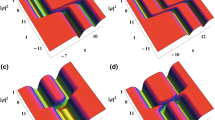Abstract
The safe storage and transmission of data continues to be a challenge because of increasing threats to the confidentiality and integrity of information. In this paper we propose a new purpose of a security scheme by employing electro-optic modulator and Michelson interferometer. Here we have reported a new scheme of controlling the power shape function of a Gaussian optical pulse propagated through electro-optic phase modulator and nonlinear waveguide for generation of soliton. Now introducing these soliton within a Michelson interferometer where we get bright and dark fringes. The required bright fringes can be recovered and discovered by a photodetector.

Similar content being viewed by others
References
A. Sinha, S. Mukhopadhyay, A study on the considering of the non-linear phenomenon of refractive index in material dispersion. J. Opt. 34(3), 140 (2005)
A. Hasegawa, F. Tappert, Transmission of stationary non-linear optical pulses in dispersive dielectric fibre. Appl. Phys. Lett 23, 171 (1973)
G.P. Agarwal, Applications of Non-linear fiber optics (Academic Press, Cambridge, 2001)
M. Nakazawa, Soliton transmission in telecommunication networks. IEEE Commun. Mag. 32(3), 34–41 (1994)
A. Hasgewa, Y. Kodama, Solitons in optical communications. Oxford (1995)
A. Sinha, S. Mukhopadhyay, Effect of higher order non-linearity in frequency variation of self-phase modulation in optical fiber communication. Chin. Opt. Lett. 2(9), 500 (2004)
E. Katrin, C. Lundevall, P. Meulen, Studies of the fifth-order nonlinear susceptibility of ultraviolet-grade fused silica. Opt. Lett. 26(12), 896 (2001)
A. Miks, J. Novák, Four-element optical system for Fourier transform. In: Proc. of the SPIE, Automatic Target Recognition XIV 5457: 284–291 (2004)
M. Lakshmanan, T. Kanna, Shape changing collisions of optical soliton, universal logic gates and partially coherent Solitons in coupled non-linear Schrodinger equations. Pramana 57(5 & 6), 885 (2001)
P. Kuila, A. Sinha, S. Mukhopadhyay, An all-optical remote controlled-nor logic using soliton pulse. Optoelectron. Lett. 4(5), 365 (2008)
Q. Zhou, L. Liu, H. Zhang et al., Analytical study of Thirring optical solitons with parabolic law nonlinearity and spatio-temporal dispersion. Eur. Phys. J. Plus 130(7), 1–6 (2015)
Q. Zhou, Q. Zhu et al., Thirring optical solitons in birefringent fibers with spatio-temporal dispersion and Kerr law nonlinearity. Laser Phys. 25(1), 015402 (2014)
Q. Zhou, M. Mirzazadeh, E. Zerrad, A. Biswas, M. Belic, Bright, dark, and singular solitons in optical fibers with spatio-temporal dispersion and spatially dependent coefficients. J. Modern Opt. 63(10), 950–954 (2016)
A. Biswas, S. Arshed, Optical solitons in presence of higher order dispersions and absence of self-phase modulation. Optik 74, 452–459 (2018)
S. Liu, Q. Zhou, A. Biswas et al., Phase-shift controlling of three solitons in dispersion-decreasing fibers. Nonlinear Dyn. 98(1), 395–401 (2019)
P. Kuila, A. Sinha, S. Mukhopadhyay, Theoretical study of using an amplitude modulation scheme with an electro-optic modulator for generation of the proper power shape function of an optical soliton pulse in a non-linear waveguide. Opt. Eng. 45(4), 045002 (2006)
A. Sinha, A theoretical investigation of the change of the width of Gaussian pulse after propagating a long distance through an optical fibre due to its inherent character. Wesley. J. Res. 10(1), 34 (2017)
Z. Jiang, D.E. Leaird, A.M. Weiner, Line-by-line pulse sha** control for optical arbitrary waveform generation. Opt. Exp. 13(25), 10431–10439 (2005)
I.S. Amiri, D. Gifany, J. Ali, Ultra-short multi soliton generation for application in long distance communication. J. Basic Appl. Sci. Res. 3(3), 442–451 (2013)
Author information
Authors and Affiliations
Corresponding author
Additional information
Publisher's Note
Springer Nature remains neutral with regard to jurisdictional claims in published maps and institutional affiliations.
Rights and permissions
About this article
Cite this article
Mandal, S., Sinha, A. An analytical approach of soliton-based binary code suppression and recovery by proper using of electro-optic modulator and Michelson interferometer. J Opt 51, 500–504 (2022). https://doi.org/10.1007/s12596-021-00797-6
Received:
Accepted:
Published:
Issue Date:
DOI: https://doi.org/10.1007/s12596-021-00797-6




